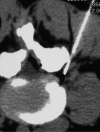Intraforaminal O(2)-O(3) versus periradicular steroidal infiltrations in lower back pain: randomized controlled study
- PMID: 15891150
- PMCID: PMC8158626
Intraforaminal O(2)-O(3) versus periradicular steroidal infiltrations in lower back pain: randomized controlled study
Abstract
Background and purpose: Reports about steroids and oxygen-ozone therapy to treat lower back pain have been increasing. The purpose of our study was to compare the clinical outcomes in patients treated with infiltrations of O(2)-O(3) gas or steroids at short-, medium-, and long-term follow-up.
Methods: A total of 306 patients (166 with primarily disk disease, 140 with nondisk vertebral disease) with acute or chronic low back and sciatic nerve pain received a CT-guided intraforaminal infiltration of an O(2)-O(3) gas mixture or an periradicular infiltration of steroids. Neurologists unaware of the type of treatment assessed the patients.
Results: At 1-week follow-up, most patients had a complete remission of pain, regardless of the treatment. At 6-month follow-up, differences in favor of O(2)-O(3) treatment were significant in patients with disk disease (P = .0021) but not in those without disk disease (P = .0992). Clinical outcomes were poor in 13 (15.1%) of 86 patients receiving O(2)-O(3) infiltration and in 18 (22.5%) of 80 patients receiving steroid injection (P = .2226). Among patients without disk disease, six (8.6%) of 70 patients receiving O(2)-O(3) infiltration but 21.4% of the patients receiving steroid injections had poor outcomes (P = .0332).
Conclusion: Oxygen-ozone treatment was highly effective in relieving acute and chronic lower back pain and sciatica. The gas mixture can be administered as a first treatment to replace epidural steroids.
Figures




Comment in
-
Therapeutic periradicular injections: it's a gas!AJNR Am J Neuroradiol. 2005 May;26(5):988-9. AJNR Am J Neuroradiol. 2005. PMID: 15891147 Free PMC article. No abstract available.
-
Ozone therapy and lower back pain.AJNR Am J Neuroradiol. 2006 Mar;27(3):471; author reply 471. AJNR Am J Neuroradiol. 2006. PMID: 16551979 Free PMC article. No abstract available.
References
-
- Czervionke LF. Lumbar intervertebral disc disease. Neuroimag Clin North Am 1993;3:465–485
-
- Davis RA. A long-term outcome analysis of 984 surgically treated herniated lumbar discs. J Neurosurg 1994;80:415–421 - PubMed
-
- Iliakis E. Ozone treatment in low back pain. Orthopaedics 1995;1:29–33
-
- Andreula CF. Ernie discali lombosacrali e patologia degenerativa correlate: trattamento interventistico spinale con chemiodiscolisi con nucleoptesi con O3 e infiltrazione periradicolare e periganglionare. Rivista di Neuroradiologia 2001;14:81–88
Publication types
MeSH terms
Substances
LinkOut - more resources
Full Text Sources
Medical
